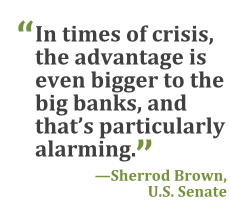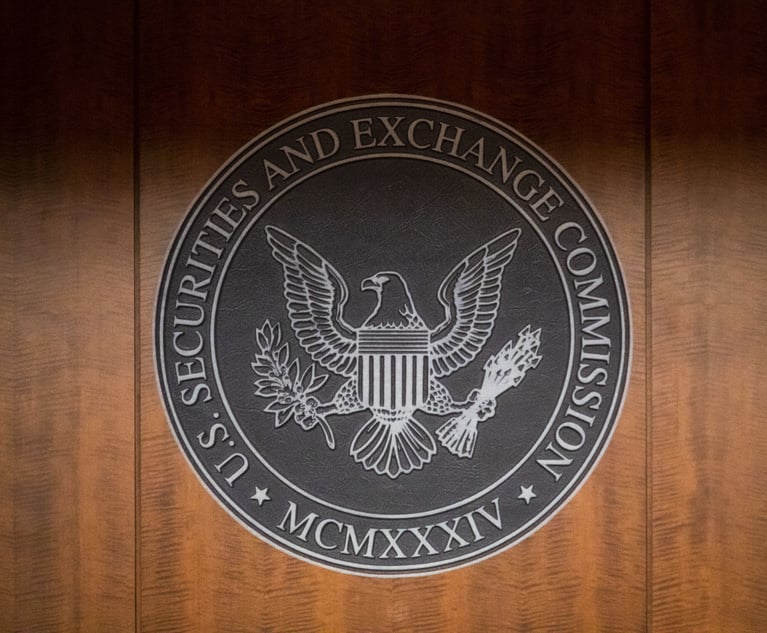The largest U.S. banks enjoyed lower funding costs than smallerrivals during the 2008 economic crisis although that advantage hasdeclined or reversed in recent years, according to testimony from agovernment watchdog.
|A study by the Government Accountability Office (GAO), to bereleased in full later today, comes after two years ofcongressional and industry debate over whether large banks continueto get what has come to be known as a too-big-to-fail subsidydespite regulatory changes. Senators Sherrod Brown, a Democrat fromOhio, and David Vitter, a Louisiana Republican, requested thereport in January 2013 and have scheduled a Senate Bankingsubcommittee hearing on it today.
| The GAO study found that the largest banks receive more ofa market advantage during financial turmoil than during economicboom times. However, the watchdog found that such advantagesdeclined or reversed in 2013, according to testimony from LawranceEvans, director of financial markets and community investment forthe GAO.
The GAO study found that the largest banks receive more ofa market advantage during financial turmoil than during economicboom times. However, the watchdog found that such advantagesdeclined or reversed in 2013, according to testimony from LawranceEvans, director of financial markets and community investment forthe GAO.
“In times of crisis, the advantage is even bigger to the bigbanks, and that's particularly alarming,” Brown said in a BloombergTV interview.
|The report appears to provide support for both sides of thedebate: Community bankers can claim they are still at adisadvantage. The largest financial institutions can highlight thedecreased level of any advantage.
|Voter anger soared over the use of hundreds of billions oftaxpayer dollars to save large banks during the 2008 financialcrisis. In response, Dodd-Frank gave regulators stronger authorityto dismantle large troubled financial institutions. It also imposedhigher capital and liquidity standards, as well as annual stresstests to assure they can withstand future crises.
|A Treasury official who asked not to be named in advance of thereport's release said it shows that the advantage banks enjoyedduring the crisis has largely been eliminated.
|“These findings reflect increased market recognition of what wehave consistently said: Dodd-Frank ended 'too big to fail' as amatter of law,” the official said in a statement.
|According to Evans' testimony, the GAO found that the largestbanks had lower funding costs during the 2007-2009 financial crisisand those differences have since declined. The agency found “mixedevidence of such advantages in recent years.” Evans didn't quantifythe size of the subsidy.
|In general, the GAO found that Dodd-Frank reforms, such asenhanced capital and liquidity standards, make the likelihood of agovernment bailout less likely while not completely eliminating it,Evans said.
|'Competitive Disadvantage'
|“Regardless of the size of the subsidy, a subsidy is a subsidy,and it ebbs and flows but there is always subsidy,” said CamdenFine, president of the Independent Community Bankers of America.“Therefore, there is always a competitive disadvantage forcommunity banks against mega-banks.”
|Representatives of large banks have argued that any marketadvantages accruing from the notion that the government will rescuethem in a crisis are insignificant. The Clearing House Association,which represents the largest commercial banks, released a report onJuly 28 that found “no evidence” that large banks enjoy anycompetitive advantages associated with market perceptions ofimplicit government support.
|“We found that the funding differential has substantiallysubsided and some of the reports actually show there are no fundingadvantages,” Paul Saltzman, president of the Clearing HouseAssociation, said in an interview. “Regardless, those fundingdifferentials are more than offset by the macro-prudential rulesthat are targeted to the large banks.”
||Rob Nichols, president of the Financial Services Forum, a tradegroup representing CEOs of the largest financial firms, said anysubsidy results mostly from investors' preference for stability,diversity, and liquidity of the large banks.
|“The GAO report confirms what we have seen in many recentstudies: any cost-of-funding differential large banks once had hasbeen dramatically reduced if not eliminated,” Nichols said in astatement. “Any very small difference remaining is consistent withcost-of-funding differentials seen in larger businesses across allsectors of the economy.”
|Brown said the report reinforces his view that in times ofcrisis investors rely more on large banks.
|“What matters is the investors, the market thinks 'too big tofail' still exists,” Brown said. “In times of economic crisis theyare going to go in greater number to larger banks getting evenbigger subsidies than they do now.”
|Persistent Perception
|Some lawmakers remain unconvinced that Dodd-Frank solvedthe-too-big-to-fail perception and have called for changesincluding higher capital requirements, decreasing the size ofinstitutions, and new bankruptcy rules.
|Brown and Vitter have proposed legislation to require banks withmore than $500 billion in assets to hold capital of at least 15percent of their assets, which is more than double theinternational Basel III standard.
|Senators Elizabeth Warren, a Massachusetts Democrat, and JohnMcCain, an Arizona Republican, have introduced a bill that wouldcreate a new version of the Glass-Steagall Act, the Depression-erameasure that separated commercial and investment banking until itsrepeal in 1999. Neither the Brown nor Warren bills have seenmovement in Congress.
|The Dodd-Frank Act defines banks with at least $50 billion inassets as “systemically important,” subjecting them to additionalrules and regulatory oversight. Regional banks have fought toincrease that threshold to cover just the largest financialinstitutions.
|The International Monetary Fund released a report in April thatfound that even after Dodd-Frank was adopted, the biggest U.S.banks saved $70 billion in funding costs because of their size. TheNew York Federal Reserve published a paper in March showing thefive largest banks paid on average 0.31 percentage points less onA-rated debt than their smaller peers from 1985 to 2009. The reportdidn't account for regulatory changes since the passage ofDodd-Frank.
|It is unclear how much the debate over large banks' advantageswill subside with the GAO report. Brown is among those in line tobe Banking Committee chairman if Democrats retain the Senate.
|“Unfortunately this is an issue that can only be proved one wayor another in the next crisis, and no one wants that to happen,”Saltzman said.
|Copyright 2018 Bloomberg. All rightsreserved. This material may not be published, broadcast, rewritten,or redistributed.
Complete your profile to continue reading and get FREE access to Treasury & Risk, part of your ALM digital membership.
Your access to unlimited Treasury & Risk content isn’t changing.
Once you are an ALM digital member, you’ll receive:
- Critical Treasury & Risk information including in-depth analysis of treasury and finance best practices, case studies with corporate innovators, informative newsletters, educational webcasts and videos, and resources from industry leaders.
- Exclusive discounts on ALM and Treasury & Risk events.
- Access to other award-winning ALM websites including PropertyCasualty360.com and Law.com.
*May exclude premium content
Already have an account? Sign In
© 2024 ALM Global, LLC, All Rights Reserved. Request academic re-use from www.copyright.com. All other uses, submit a request to [email protected]. For more information visit Asset & Logo Licensing.







